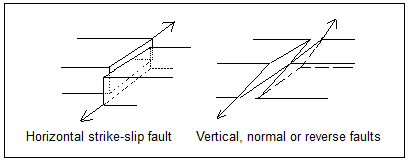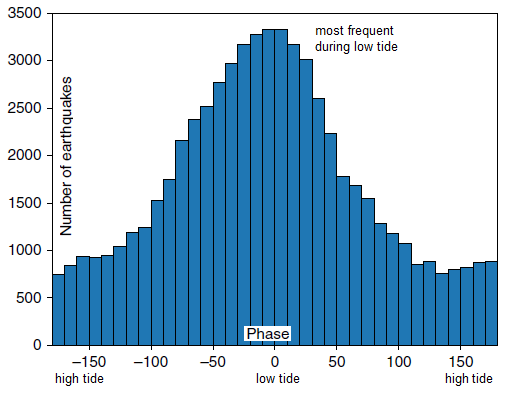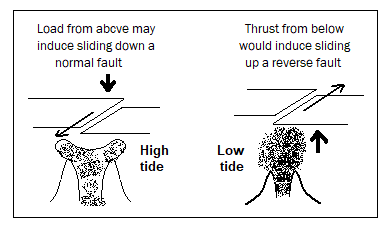Relieving a load is sometimes the same as adding a large burden, says S.Ananthanarayanan.
">The earth’s crust formed as its outer layers of molten rock cooled and solidified. The crust, however, did not form all once or in one piece, but in separate segments. These segments, called tectonic plates, were generally in relative motion and they shuffled about until they found orientations with greater stability. The crust is now largely firm, but imperfections remain and the plates of rock still need to shift and resettle. These events, where the plates slide over each other, are what we know as tremors or earthquakes.
Christopher H. Scholz, Yen Joe Tan and Fabien Albino from Columbia University and the University of Bristol, in a paper in the journal, Nature Communications, examine a case where ocean tides promote or suppress such shifting of earth’s crust, at great depths, on the seabed. And in the process, they find the answer to an old question about the mechanism by which ocean tides bring about earthquakes
Adjacent faces of discontinuities, or weak sections of the crust, are known as faults. Uneven pressures along the faults could cause movement of the crust, horizontally, or along inclines, of the plates on the two sides of a fault. If there were friction, or adhesion between the two faces, the pressure would build up, until it overcomes resistance, with sudden and energetic movement of the two parts of the crust. The faults could extend to miles on end and earthquakes, as we well know, could be severe, indeed.
While tremors and upheavals of the earth, in the process of realignment of tectonic plates, happen from time to time, they could also be the result of forces or thrust. These could arise from a distant earthquake, erosion or buildup of landmass, or even manmade causes, like excavation or the use of explosives. And yet another source of pressures are the gravitational forces of the moon and the sun, which tug and pull on the material of the earth.
These last are powerful forces, which cause tidal deformation, as the earth rotates and the moon goes around the earth. The same force, caused by the earth, on the moon, has affected the rotation of the moon, so that its speed of rotation is only once every lunar month. The earth’s gravity has hence effectively locked one face of the moon to be always facing the earth. The effect of the moon on the earth are the ocean tides, which rise and fall when the moon is directly overhead or on the opposite side of the earth, or just rising or setting. While ocean tides are clearly visible, the part of the land directly towards the moon is also powerfully pulled towards the moon. This effect, of course, is not noticeable, as rock and earth are not fluid, like the sea. However, as ocean tides are large and energetic, the authors of the paper have studied the effect that ocean waves have on the realignment of the crustal faults that are found on the seabed.
Faults along the seabed are broadly of three kinds, the horizontal strike-slip fault or the vertical or slanting, ‘dip-slip’, normal or reverse faults. In Strike-sllip faults, one plate slides to one side, along another, and in the other kind, one plate slides down another face, or slides up. While different kinds of thrusts can bring about such movements, it is of interest to see what effect the vertical pressure, arising out of the greater mass of water that collects during high tide, would have.

As tides cause loading of the mass above the faults, it has been known and the extensive record available shows that occurrence of seabed earthquakes is correlated with the tides. But the surprise is that the earthquakes occur more often during low tide than during high tide. As the main force acting on the matter of the crust is its own and other downward weight, it is reasonable to think that it is an increase of the load, in the form of thousands of tonnes of seawater, during high tide, would make more likely an earthquake caused by a vertical slip along a normal fault. The time of low tide is one of lesser load and this should be an inhibitor of movement down a normal fault, rather than the promoter or a trigger to overcome resistance and set off a cascade of landmass.
The authors of the paper observe that the mid-ocean ridges, which are associated with underwater volcanic action, would be the most promising place to test theories of earthquake triggering. Accordingly, they study the records of the Juan de Fuca ridge, a mid-ocean mountain system in the Pacific Northwest region, formed by movement of crustal plates. The ridge is also home to Axial Seamount, an underwater volcano, 1400 meters below sea level.
The authors cite the data collected during three months preceding an eruption of the Axial in 2015, and the frequency of earthquakes, as shown in the diagram, was the highest during low tide. The paper explains that the earthquakes were dominated by ‘normal faulting’, with a mean fault dip of 67°. The reduction of the vertical load, during low tide, should hence have the effect of reducing the tendency to slip down such a steep slope, and it is the high tide, with a rise in the load, that should encourage slip, the paper says.

The factor that explains the paradox is found to be an additional, upward force, which has not been considered so far. This is from the volume of molten or nearly molten matter that lies beneath the fault. The Axial Volcano being an active volcano that erupts every decade, the collected molten material, the magma, is depleted after every eruption, followed by build-up until the next eruption. The crust above the volcano is thus sitting atop a cushion that could rise or fall, according to the pressure it is under.

During high tide, the weight of water tends to balance the upward thrust by magma, or could be considered to be balanced by the same thrust. During low tide, however, the balancing load is relieved, and the lower tectonic plates are pushed up the sloping separation at the faults.
It was the great sensitivity of seismic activity to tidal forces in the Juan de Fuca ridge that enabled the mechanism to be worked out, the paper says.
------------------------------------------------------------------------------------------ Do respond to : response@simplescience.in